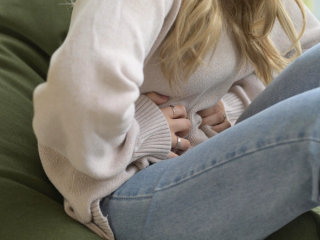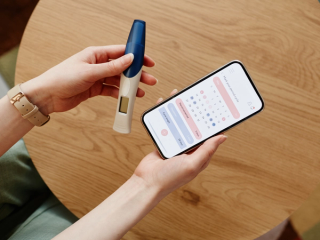
- Home
- Advice Hub
- Conception
- Fertility & Infertility
- Fibroids And Fertility: What You Need To Know
Fibroids and fertility: what you need to know when trying to conceive
Explore fibroids and fertility: understand fibroid size impact, benefits of removal for conception, and ways to diagnose infertility causes.
Around 2 in 3 women develop a uterine fibroid during their life non-cancerous growths that develop in or around the womb (uterus). For many women, these fibroids are not problematic and cause no symptoms at all, however for women trying to conceive they can sometimes pose challenges depending on their size, location, and number. Here, we’re going to explore the relationship between fibroids and fertility, including the different types of fibroids, how they might affect your chances of conceiving and symptoms to watch out for.
What are uterine fibroids?
Fibroids, also known as leiomyomas or myomas, are benign (non-cancerous) tumours that grow in or around the uterus. They are composed of muscle and fibrous tissue and vary widely in size, from as small as a pea to as large as a melon!
Fibroids can impact any woman of reproductive age, more commonly between the ages of 30 and 50. Being overweight or obese increases your risk of developing a fibroid and they are thought to occur more frequently in women of African-Caribbean origin. After bearing children, the risk of developing fibroids reduces. It’s important to note that while many women will develop fibroids at some point in their lives, not all will experience fertility issues as a result.
Types of fibroids and their impact on fertility
There are three main types of uterine fibroids, classified by their location in the uterus.
1. Subserosal Leiomyomas (Fibroids)
Subserosal fibroids are located just under the uterine serosa (the outermost layer of the uterus). These fibroids may be broad based (sessile) or could be attached to the body of the uterus by a narrow stalk (pendunculated). Because they grow on the outer surface of the uterus, they have less impact on fertility. However, they can cause abnormal bleeding and pelvic pressure, which might lead you to seek diagnosis through an ultrasound scan or other diagnostic method (e.g. laparoscopy).
2. Intramural Leiomyomas (Fibroids)
Intramural fibroids are found predominantly within the thick myometrium (the middle layer of the uterus) but may distort the shape of the uterus, which can impact fertility, pregnancy and labour. Large fibroids can also interfere with bowel movements, which may cause constipation, frequent urination and incontinence. Your healthcare professional would be able to check the shape and size of your uterus with a bimanual pelvic exam – an enlarged or irregularly shaped uterus can be felt above the pubic bone. Of course, scans will also be needed to confirm the diagnosis.
3. Submucous Leiomyomas (Fibroids)
Submucous fibroids are located just under the uterine mucosa (endometrium, or inner layer of the uterus) and, like subserosal leiomyomas, may be either pedunculated or sessile. Fibroids within the uterus can cause reproductive problems, for example, by blocking the fallopian tubes (preventing sperm from reaching the egg), distorting the shape of the uterine cavity, and increasing the risk of miscarriage and pre-term labour.
If you’re experiencing prolonged bleeding or recurrent miscarriages, it’s worth exploring whether a submucous fibroid is the cause. It may not be picked up on a traditional ultrasound, so your healthcare professional may recommend a hysteroscopy, a procedure in which a camera is inserted through the vagina and cervix into the uterus.
How can fibroids affect fertility?
Based on the above, we can see that fibroids can affect fertility, but don’t always. It depends mainly on their type, size, number, and most critically, their location within the uterus.
The presence of small fibroids generally does not interfere with fertility, especially if they are not located within the uterine cavity. However, even small fibroids may cause issues if they are submucosal or positioned in a way that distorts the endometrial lining. Therefore, the location remains more critical than size alone in determining their effect on conception and pregnancy.
If you are having trouble conceiving or are concerned about risks during pregnancy, speak to your doctor.
Can you get pregnant with fibroids?
Yes, many women with fibroids go on to have healthy pregnancies and births.
If you have experienced symptoms of fibroids and are actively trying to conceive, your doctor may recommend imaging tests to determine the presence and positioning of any fibroids. There are treatment options, including medicines to reduce the fibroid size and surgery for fibroid removal. Understanding your individual risks and working with a specialist can help optimise your chances of conception.
FAQs: fibroids and fertility
It depends on where the fibroid is. Submucous fibroids are more strongly correlated with fertility problems, so even small fibroids there might cause an issue. Larger intramural fibroids (above 6cm) can also cause fertility problems.
In some cases, yes. Surgical treatments such as myomectomy (fibroid removal) and other medical and surgical treatments can restore the normal shape and function of the uterus, improve implantation rates, and reduce the risk of miscarriage. However, the decision to remove fibroids is highly individual and depends on factors such as symptoms, fertility goals, and the type of fibroid. Talk to a specialist to see which treatment might be best for you.
If you're experiencing heavy periods, pelvic pain, or unexplained fertility problems, it may be worth investigating. Getting a diagnosis typically involves pelvic examinations, ultrasound scans, or MRI imaging to assess fibroid size, placement and type. Your doctor will then advise you on your treatment options if necessary.
In summary
Fibroids are a common and often manageable part of reproductive health. While they can impact fertility for some women, many others conceive naturally or with minimal intervention. If you suspect fibroids may be affecting your ability to conceive, speak with your GP or a fertility specialist to explore your options. With the right support, most women go on to have successful pregnancies despite a fibroid diagnosis.











